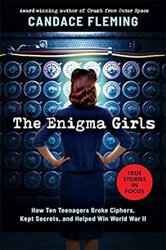
 The Enigma Girls
The Enigma GirlsHow Ten Teenagers Broke Ciphers, Kept Secrets, and Helped Win World War II
Review posted May 3, 2024.
Scholastic Focus, 2024. 371 pages.
Review written April 29, 2024, from a library book.
Starred Review
2024 Sonderbooks Standout:
#9 Children's Nonfiction
We've all heard stories about Alan Turing breaking the Enigma code in World War II, right? But did you know that literally thousands of girls under the age of 21 were also involved in monitoring enemy communications during World War II?
In this book, the title tells us that we're tracking ten of those teenage girls, but honestly my one quibble with the book was that I couldn't keep them straight at all. She was still introducing new characters toward the end of the book. But what made the book amazing despite that was the picture it gave of code breaking and intelligence gathering as the war progressed and what a large operation it grew to be, and how important. And taking the perspective of teenage girls who worked in this field brings home how many ordinary people were caught up in the effort.
The book progresses chronologically. It sounds like early on, they'd figured out how Enigma worked. Every day the settings changed, so every day they'd work on breaking the code. Once the code was broken, the cryptographers moved on to something else, and they had machines where girls would type in the messages with the new settings, and decoded messages would come out.
Then later in the war, they used giant computers that were programmed by connecting and disconnecting actual wires. In another department they'd figure out the settings, then they had the girls set up and run the machine. Another department translated messages from German and Italian. Another department indexed the messages on 3x5 cards to be able to understand the messages better. Other girls were hired to check radio frequencies and listen for messages and transcribe what they heard. According to a chart, by the end of the war, 2,237 men and 6,758 women worked at Bletchley Park, and most of those women were under 21 years old.
This book makes all of that fascinating. I liked the short chapters with lots of photographs. Yes, it was hard to keep track of so many characters, but it did give the idea that many young women were working there, doing many different jobs. And they worked in total secrecy, unable to tell their family and friends what important war work they were doing. I was impressed that the Germans never knew that their codes had been broken, and the valuable intelligence gathered definitely helped win the war. I now very much want to visit the Bletchley Park Museum some day.
This book is written for kids ages 8 through 12, and I think older kids (and adults like me) will be intrigued by this story of ordinary young women using their talents to win a war.
